The burn-wet gas abatement system market is anticipated to expand from USD 384.5 million in 2025 to USD 944.2 million by 2035, at a CAGR of 9.4%. demonstrating the accelerating adoption of advanced emission control systems and abatement technologies across semiconductor manufacturing, industrial facilities, and environmental compliance centers worldwide.
The first half of the decade (2025-2030) will witness the market climbing from USD 384.5 million to approximately USD 550.8 million, adding USD 166.3 million in value, which constitutes 29.5% of the total forecast growth period. This phase will be characterized by the rapid adoption of advanced abatement systems, driven by increasing environmental regulations and emission control modernization programs worldwide. Enhanced treatment capabilities and integrated monitoring features will become standard expectations rather than premium options.
The latter half (2030-2035) will witness steady growth from USD 550.8 million to USD 944.2 million, representing an addition of USD 393.4 million or 70.5% of the decade's expansion. This period will be defined by mass market penetration of comprehensive environmental control platforms, integration with industrial management systems, and seamless compatibility with existing manufacturing infrastructure. The market trajectory signals fundamental shifts in how manufacturers approach emission control and environmental compliance, with participants positioned to benefit from constant demand across multiple application segments.
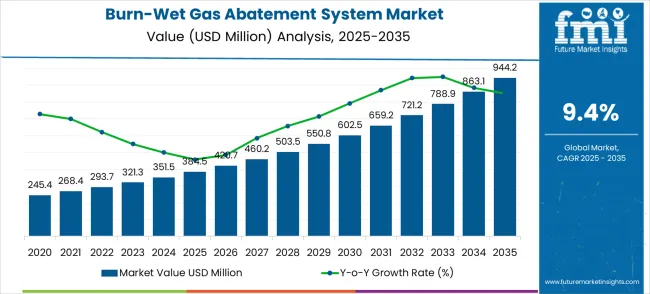
The market demonstrates distinct growth phases with varying market characteristics and competitive dynamics. Between 2025 and 2030, the market progresses through its technology adoption phase, expanding from USD 384.5 million to USD 550.8 million with steady annual increments averaging 9.7% growth. This period showcases the transition from basic emission control systems to advanced abatement platforms with enhanced efficiency capabilities and integrated environmental workflow systems becoming mainstream features.
The 2025-2030 phase adds USD 166.3 million to market value, representing 29.5% of total decade expansion. Market maturation factors include standardization of emission control protocols, declining manufacturing costs for abatement systems, and increasing industrial awareness of burn-wet gas benefits reaching 90-95% efficiency in emission control applications. Competitive landscape evolution during this period features established environmental technology companies like EcoSys and Centrotherm Clean Solutions expanding their emission control portfolios while new entrants focus on specialized abatement algorithms and enhanced integration capabilities.
From 2030 to 2035, market dynamics shift toward advanced integration and multi-platform deployment, with growth accelerating from USD 550.8 million to USD 944.2 million, adding USD 393.4 million or 70.5% of total expansion. This phase transition logic centers on comprehensive environmental platforms, integration with industrial information systems, and deployment across diverse manufacturing specialties, becoming standard rather than specialized applications. The competitive environment matures with focus shifting from basic abatement capability to comprehensive environmental ecosystems and integration with automated emission monitoring and compliance management platforms.
| Metric | Value |
|---|---|
| $ Market Value (2025) → | USD 384.5 million |
| $ Market Forecast (2035) ↑ | USD 944.2 million |
| # Growth Rate ★ | 9.4% CAGR |
| Leading Column Type → | Single Column |
| Primary Application → | Semiconductor |
The market demonstrates strong fundamentals with the single column type capturing a dominant share through advanced efficiency features and cost-effective implementation capabilities. Semiconductor applications drive primary demand, supported by increasing manufacturing facility spending on emission control tools and environmental compliance enhancement systems. Geographic expansion remains concentrated in developed markets with established industrial infrastructure, while emerging economies show accelerating adoption rates driven by environmental modernization and rising emission control budgets.
Market expansion rests on three fundamental shifts driving adoption across industrial and environmental sectors. 1. Environmental compliance demand creates compelling operational advantages through abatement systems that provide immediate emission control without safety risks, enabling manufacturing professionals to manage harmful gases while maintaining environmental superiority and reducing regulatory violation risks. 2. Industrial modernization programs accelerate as manufacturing facilities worldwide seek advanced emission control systems that complement traditional environmental methods, enabling precise gas abatement and monitoring applications that align with environmental standards and regulatory requirements. 3. Manufacturing infrastructure enhancement drives adoption from semiconductor fabs and industrial centers requiring effective abatement tools that minimize emission errors while maintaining production quality during complex manufacturing procedures and environmental planning.
However, growth faces headwinds from regulatory compliance challenges that vary across jurisdictions regarding the deployment of emission control systems and environmental safety protocols, which may limit operational flexibility in certain industrial environments. Technical limitations also persist regarding abatement efficiency and integration complexity that may reduce system performance with legacy manufacturing equipment or non-standardized emission formats that limit processing capabilities.
The burn-wet gas abatement system market represents a transformative growth opportunity, expanding from USD 384.5 million in 2025 to USD 944 million by 2035 at a 9.4% CAGR. As industrial systems worldwide prioritize emission control, operational efficiency, and environmental compliance, abatement systems have evolved from specialized equipment to mission-critical infrastructure enabling clean manufacturing, reducing environmental impact, and supporting regulatory compliance across semiconductor, photovoltaic, and industrial applications.
The convergence of environmental regulation mandates, increasing manufacturing requiring emission control, industrial automation maturation, and regulatory acceptance of advanced abatement devices creates unprecedented adoption momentum. Advanced emission control algorithms offering superior efficiency, seamless industrial integration, and regulatory compliance will capture premium market positioning, while geographic expansion into emerging industrial markets and scalable system deployment will drive volume leadership. Government environmental modernization programs and emission control standardization provide structural support.
Primary Classification: The market segments by column type into Single Column and Dual Column categories, representing the evolution from traditional single-stage treatment to advanced multi-stage solutions for comprehensive emission control coverage.
Secondary Breakdown: Application segmentation divides the market into Semiconductor, Photovoltaic, and Others sectors, reflecting distinct requirements for chip manufacturing, solar production, regulatory compliance, and specialized industrial applications.
Regional Classification: Geographic distribution covers Asia Pacific, North America, Europe, Latin America, and the Middle East & Africa, with developed markets leading adoption while emerging economies show accelerating growth patterns driven by environmental modernization programs.
The segmentation structure reveals technology progression from traditional single-column systems toward integrated dual-column platforms with enhanced efficiency and monitoring capabilities, while application diversity spans from semiconductor emission control to comprehensive industrial and environmental solutions requiring precise abatement assistance.
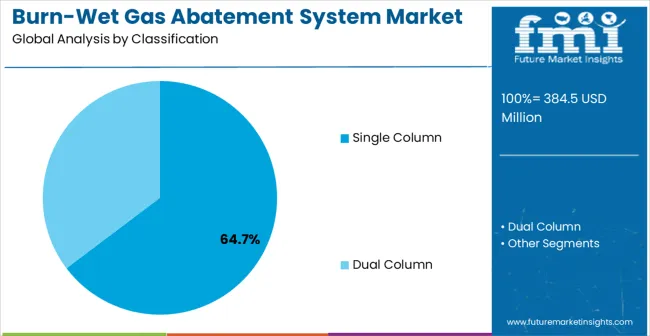
Market Position: Single Column systems command the leading position in the Burn-Wet Gas Abatement System market with approximately 64.7% market share through advanced efficiency features, including compact design, cost-effectiveness, and reliable performance capabilities that enable manufacturing facilities to deploy emission control across diverse industrial environments without significant infrastructure modifications.
Value Drivers: The segment benefits from manufacturer preference for streamlined abatement systems that provide effective emission control without requiring extensive installation protocols or specialized maintenance support. Single-column design features enable deployment in semiconductor fabs, industrial plants, and research facilities where efficiency and space optimization represent critical operational requirements.
Competitive Advantages: Single column systems differentiate through established efficiency, proven reliability, and integration with existing manufacturing workflows that enhance environmental compliance while maintaining cost-effective operational profiles suitable for industrial facilities of all sizes.
Key market characteristics:
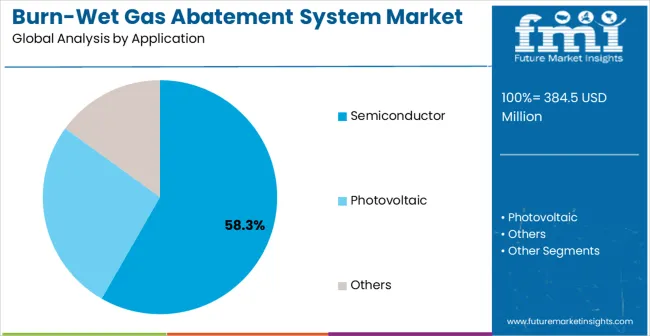
Market Context: Semiconductor applications dominate the Burn-Wet Gas Abatement System market with approximately 58.3% market share due to widespread adoption of emission control systems and increasing focus on clean manufacturing, environmental compliance, and production quality applications that minimize environmental impact while maintaining manufacturing effectiveness.
Appeal Factors: Semiconductor customers prioritize system efficiency, regulatory compliance, and integration with existing manufacturing infrastructure that enables coordinated emission control across multiple production processes. The segment benefits from substantial capital equipment budgets and modernization programs that prioritize environmental tool acquisition for improved manufacturing outcomes and operational efficiency.
Growth Drivers: Semiconductor fabrication programs incorporate abatement systems as standard equipment for emission control and environmental management applications. At the same time, increasing environmental awareness is driving demand for emission control capabilities that comply with regulatory requirements and minimize manufacturing ecological risks.
Market Challenges: Regulatory compliance requirements and technology validation processes may limit system deployment in certain manufacturing environments or production scenarios.
Application dynamics include:
Growth Accelerators: Environmental regulations drive primary adoption as abatement systems provide emission control capabilities that enable effective gas treatment without environmental safety risks, supporting manufacturing decision-making and compliance missions that require precise emission management. The demand for industrial modernization accelerates market expansion as manufacturers seek effective environmental enhancement tools that minimize emission errors while maintaining production effectiveness during complex manufacturing procedures and compliance scenarios. Environmental spending increases worldwide, creating constant demand for emission control systems that complement traditional manufacturing equipment and provide environmental flexibility in complex industrial environments.
Growth Inhibitors: Regulatory compliance challenges vary across jurisdictions regarding the deployment of emission control systems and environmental safety protocols, which may limit operational flexibility and market penetration in regions with restrictive environmental technology regulations. Technical performance limitations persist regarding abatement efficiency and system integration that may reduce effectiveness with legacy manufacturing equipment, non-standardized emission formats, or complex industrial workflows that limit processing capabilities. Market fragmentation across multiple environmental standards and regulatory requirements creates compatibility concerns between different abatement system providers and existing manufacturing infrastructure.
Market Evolution Patterns: Adoption accelerates in semiconductor and industrial sectors where emission control justifies system costs, with geographic concentration in developed markets transitioning toward mainstream adoption in emerging economies driven by environmental modernization and industrial infrastructure development. Technology development focuses on enhanced abatement efficiency, improved automation capabilities, and compatibility with diverse manufacturing systems that optimize production workflow and environmental effectiveness. The market could face disruption if alternative emission control technologies or regulatory restrictions significantly limit burn-wet gas abatement deployment in manufacturing or industrial applications.
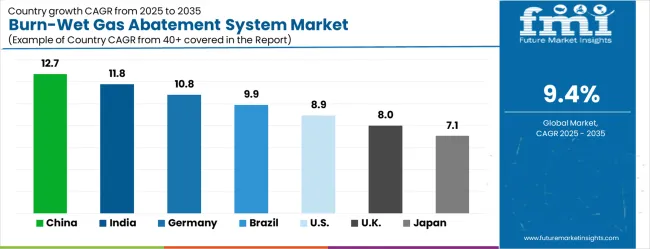
The market demonstrates varied regional dynamics with Growth Leaders including China (12.7% CAGR) and India (11.8% CAGR) driving expansion through industrial modernization and environmental infrastructure development. Steady Performers encompass Germany (10.8% CAGR), Brazil (9.9% CAGR), and the USA (8.9% CAGR), benefiting from established manufacturing industries and advanced emission control technology adoption. Emerging Markets feature the UK (8.0% CAGR) and Japan (7.1% CAGR), where specialized industrial applications and environmental technology integration support consistent growth patterns.
| Country | CAGR (2025-2035) |
|---|---|
| China | 12.7% |
| India | 11.8% |
| Germany | 10.8% |
| Brazil | 9.9% |
| USA | 8.9% |
| UK | 8.0% |
| Japan | 7.1% |
Regional synthesis reveals Asia-Pacific markets leading growth through industrial modernization and environmental infrastructure development, while European countries maintain steady expansion supported by environmental technology advancement and EU emission control standardization requirements. North American markets show moderate growth driven by semiconductor applications and industrial technology integration trends.
China establishes market leadership through aggressive industrial modernization programs and comprehensive environmental infrastructure development, integrating advanced burn-wet gas abatement systems as standard components in semiconductor manufacturing and industrial emission control applications. The country's 12.7% CAGR through 2035 reflects government initiatives promoting environmental technology and domestic manufacturing capabilities that mandate advanced abatement systems in industrial facility installations. Growth concentrates in major industrial centers, including Beijing, Shanghai, and Shenzhen, where environmental technology development showcases integrated abatement systems that appeal to domestic manufacturers seeking advanced emission control capabilities and ecological compliance applications.
Chinese manufacturers are developing cost-effective burn-wet gas abatement solutions that combine domestic production advantages with advanced features, including precision emission control algorithms and comprehensive environmental capabilities. Distribution channels through government industrial procurement and environmental equipment suppliers expand market access, while government funding for environmental technology development supports adoption across diverse manufacturing and industrial segments.
Strategic Market Indicators:
In New Delhi, Mumbai, and Bangalore, manufacturing facilities and industrial centers are implementing advanced burn-wet gas abatement systems as standard equipment for emission control and environmental compliance applications, driven by increasing industrial spending and modernization programs that prioritize the use of environmental control capabilities. The market is projected to demonstrate a 11.8% CAGR through 2035, supported by government environmental initiatives and industrial infrastructure development programs that promote advanced emission control tools for manufacturing facilities and industrial centers. Indian manufacturers are adopting burn-wet gas abatement systems that provide superior environmental control capabilities and emission reduction features, particularly appealing in industrial regions where environmental compliance represents critical operational requirements.
Market expansion benefits from growing environmental technology capabilities and international technology transfer agreements that enable domestic development of advanced emission control systems for manufacturing and industrial applications. Technology adoption follows patterns established in industrial equipment, where environmental compliance and operational efficiency drive procurement decisions and system deployment.
Market Intelligence Brief:
Germany's advanced environmental technology market demonstrates sophisticated burn-wet gas abatement deployment with documented emission control effectiveness in manufacturing departments and industrial centers through integration with existing industrial systems and ecological infrastructure. The country leverages engineering expertise in environmental technology and industrial systems integration to maintain a 10.8% CAGR through 2035. Industrial centers, including Munich, Berlin, and Hamburg, showcase premium installations where burn-wet gas abatement integrates with comprehensive manufacturing information systems and environmental platforms to optimize emission control accuracy and industrial workflow effectiveness.
German environmental technology providers prioritize system reliability and EU regulatory compliance in burn-wet gas abatement development, creating demand for premium systems with advanced features, including ecological validation and integration with European industrial standards. The market benefits from established environmental industry infrastructure and a willingness to invest in advanced emission control technologies that provide long-term environmental benefits and compliance with emission control regulations.
Market Intelligence Brief:
Brazil's market expansion benefits from diverse industrial demand, including manufacturing modernization in São Paulo and Rio de Janeiro, environmental system upgrades, and government ecological programs that increasingly incorporate emission control solutions for industrial compliance applications. The country maintains a 9.9% CAGR through 2035, driven by rising environmental awareness and increasing adoption of burn-wet gas abatement benefits, including superior emission control capabilities and reduced ecological risk.
Market dynamics focus on cost-effective burn-wet gas abatement solutions that balance advanced environmental features with affordability considerations important to Brazilian manufacturers. The growth of industrial infrastructure creates steady demand for modern emission control systems in new manufacturing facilities and industrial equipment modernization projects.
Strategic Market Considerations:
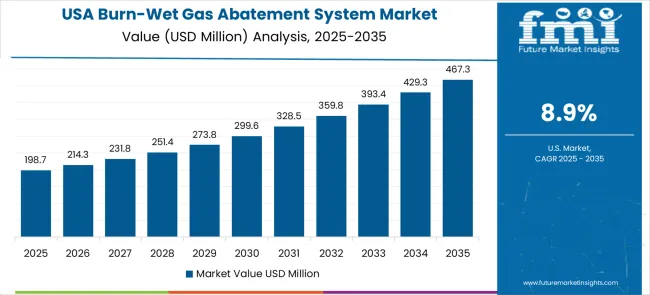
The USA market prioritizes advanced burn-wet gas abatement features, including precision emission control algorithms and integration with comprehensive manufacturing information systems that manage environmental compliance, emission monitoring, and regulatory support applications through unified industrial platforms. The country is projected to show an 8.9% CAGR through 2035, driven by industrial modernization under environmental equipment upgrades and federal ecological agency demand for reliable emission control systems. American manufacturers prioritize environmental effectiveness with burn-wet gas abatement, delivering consistent emission control assistance through advanced environmental algorithms and regulatory compliance capabilities.
Technology deployment channels include major industrial technology contractors, specialized environmental equipment suppliers, and federal environmental programs that support professional installation for complex manufacturing applications. Industrial platform integration capabilities with established environmental systems expand market appeal across diverse emission control requirements seeking environmental accuracy and regulatory compliance benefits.
Performance Metrics:
Japan demonstrates steady market development with a 7.1% CAGR through 2035, distinguished by manufacturers' preference for high-quality burn-wet gas abatement systems that integrate seamlessly with existing industrial equipment and provide reliable long-term operation in specialized emission control applications. The market prioritizes advanced features, including precision emission control algorithms, environmental validation, and integration with comprehensive industrial platforms that reflect Japanese manufacturing expectations for technological sophistication and ecological excellence.
In London, Manchester, and other industrial centers, British manufacturers and industrial facilities are implementing advanced burn-wet gas abatement systems to enhance emission control capabilities and support environmental decision-making that aligns with UK ecological standards and emission control regulations. The UK market is expected to demonstrate constant growth with an 8.0% CAGR through 2035, driven by environmental modernization programs and industrial equipment upgrades that prioritize advanced emission control tools for manufacturing and industrial applications. British industrial facilities are prioritizing burn-wet gas abatement systems that provide superior environmental control capabilities while maintaining compliance with emission control regulations and minimizing environmental risks, particularly important in semiconductor manufacturing and specialized industrial applications.
Market expansion benefits from regulatory procurement programs that mandate emission control capabilities in industrial equipment specifications, creating steady demand across the UK's manufacturing sectors where environmental effectiveness and regulatory compliance represent critical requirements. The regulatory framework supports burn-wet gas abatement adoption through environmental device standards and industrial technology requirements that promote advanced emission control systems aligned with national ecological capabilities.
Strategic Market Indicators:
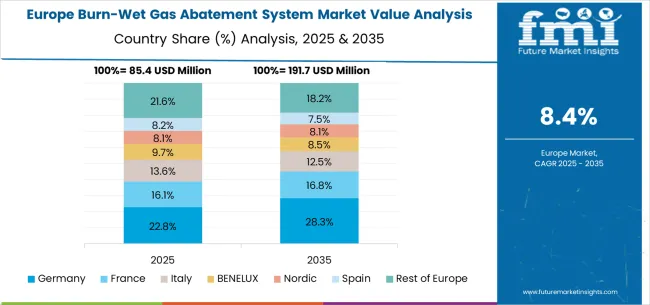
The burn-wet gas abatement system market in Europe is projected to grow from USD 83.7 million in 2025 to USD 205.7 million by 2035, registering a CAGR of 9.4% over the forecast period. Germany is expected to maintain its leadership position with a 35.2% market share in 2025, rising slightly to 35.8% by 2035, supported by its advanced environmental technology sector and major industrial centers, including Munich and Berlin.
The United Kingdom follows with a 28.3% share in 2025, projected to reach 28.7% by 2035, driven by comprehensive industrial modernization programs and environmental technology development initiatives. France holds a 16.8% share in 2025, expected to increase to 17.2% by 2035 through specialized industrial applications and regulatory standardization requirements. Italy commands an 11.7% share in 2025, rising to 11.9% by 2035, while Spain accounts for 5.8% in 2025, increasing to 6.0% by 2035. The Rest of Europe region, including Nordic countries, Eastern Europe, BENELUX, and other markets, is anticipated to hold 2.2% in 2025, declining slightly to 2.4% by 2035, attributed to mixed growth patterns with moderate expansion in some advanced industrial markets balanced by steady growth in smaller countries implementing environmental technology development programs.
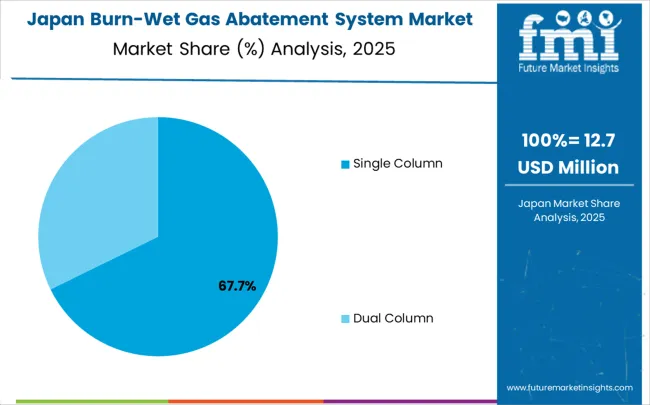
In Japan, the market prioritizes single-column systems, which capture the dominant share of manufacturing and industrial facility installations through advanced features, including superior efficiency capabilities and seamless integration with existing industrial information technology infrastructure. Japanese manufacturers prioritize reliability, emission control accuracy, and long-term operational excellence, creating demand for single-column systems that provide flexible abatement capabilities and adaptive emission control based on manufacturing requirements and environmental complexity scenarios. Dual Column systems maintain a secondary market position primarily in specialized applications and high-volume installations where enhanced capacity requirements meet environmental compliance without single-stage limitations.
Market Characteristics:
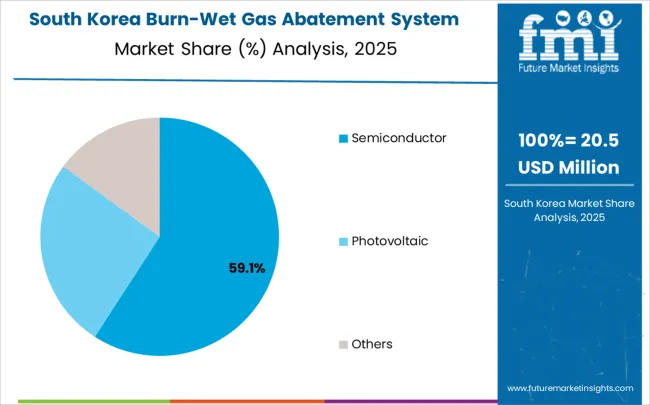
In South Korea, the market structure favors international environmental technology companies, including EcoSys, Centrotherm Clean Solutions, and Busch Vacuum, which maintain dominant positions through comprehensive product portfolios and established industrial procurement networks supporting both manufacturing systems and industrial facilities. These providers offer integrated solutions combining advanced burn-wet gas abatement systems with professional installation services and ongoing technical support that appeal to Korean manufacturers seeking reliable emission control systems. Local environmental technology contractors and system integrators capture a moderate market share by providing localized service capabilities and competitive pricing for standard industrial installations. At the same time, domestic manufacturers focus on specialized applications and cost-effective solutions tailored to Korean industrial characteristics.
Channel Insights:
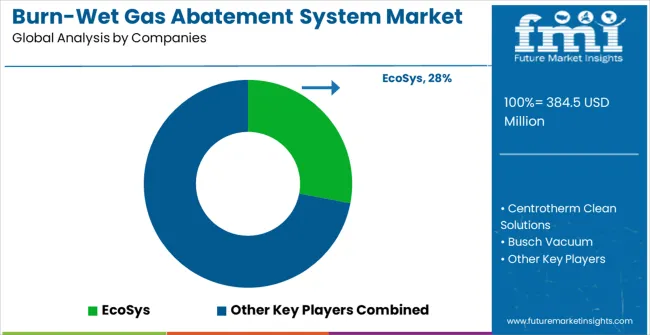
The market operates with moderate concentration, featuring approximately 12-15 meaningful participants, where leading companies control roughly 60-65% of the global market share through established environmental technology relationships and comprehensive emission control portfolios. Competition prioritizes advanced abatement capabilities, system reliability, and industrial platform integration rather than price-based rivalry.
Market Leaders encompass EcoSys, Centrotherm Clean Solutions, Busch Vacuum, Resonac, and CS Clean Solutions, which maintain competitive advantages through extensive environmental technology expertise, global industrial contractor networks, and comprehensive system integration capabilities that create customer switching costs and support premium pricing. These companies leverage decades of environmental technology experience and ongoing research investments to develop advanced burn-wet gas abatement systems with precision emission control algorithms and environmental validation features.
Technology Challengers include DAS Environmental Expert, Ebara Technologies, MAT Plus, CSK, and Highvac Corporation, which compete through specialized environmental focus and innovative emission control interfaces that appeal to industrial customers seeking advanced ecological control capabilities and operational flexibility. These companies differentiate through rapid technology development cycles and specialized industrial application focus.
Regional Specialists feature companies like Nippon Sanso and Exyte, which focus on specific geographic markets and specialized applications, including semiconductor manufacturing systems and integrated environmental platforms. Market dynamics favor participants that combine reliable emission control algorithms with advanced environmental software, including precision gas abatement and automatic ecological monitoring capabilities. Competitive pressure intensifies as traditional industrial technology contractors expand into emission control systems. At the same time, specialized environmental companies challenge established players through innovative abatement solutions and cost-effective platforms targeting specialized industrial segments.
| Item | Value |
|---|---|
| Quantitative Units | USD 384.5 million |
| Column Type | Single Column, Dual Column, Others |
| Application | Semiconductor, Photovoltaic, Others |
| Regions Covered | Asia Pacific, North America, Europe, Latin America, Middle East & Africa |
| Countries Covered | China, India, Germany, Brazil, the USA, the UK, Japan, and 25+ additional countries |
| Key Companies Profiled | EcoSys, Centrotherm Clean Solutions, Busch Vacuum, Resonac, CS Clean Solutions, DAS Environmental Expert, Ebara Technologies, MAT Plus, CSK, Highvac Corporation, Nippon Sanso, Exyte |
| Additional Attributes | Dollar sales by column type and application categories, regional adoption trends across Asia Pacific, North America, and Europe, competitive landscape with environmental technology providers and emission control specialists, manufacturer preferences for abatement efficiency and system reliability, integration with manufacturing information systems and ecological workflows, innovations in emission control algorithms and environmental analysis, and development of advanced solutions with enhanced efficiency and monitoring capabilities. |
The global burn-wet gas abatement system market is estimated to be valued at USD 384.5 million in 2025.
The market size for the burn-wet gas abatement system market is projected to reach USD 944.2 million by 2035.
The burn-wet gas abatement system market is expected to grow at a 9.4% CAGR between 2025 and 2035.
The key product types in burn-wet gas abatement system market are single column and dual column.
In terms of application, semiconductor segment to command 58.3% share in the burn-wet gas abatement system market in 2025.






Our Research Products

The "Full Research Suite" delivers actionable market intel, deep dives on markets or technologies, so clients act faster, cut risk, and unlock growth.

The Leaderboard benchmarks and ranks top vendors, classifying them as Established Leaders, Leading Challengers, or Disruptors & Challengers.

Locates where complements amplify value and substitutes erode it, forecasting net impact by horizon

We deliver granular, decision-grade intel: market sizing, 5-year forecasts, pricing, adoption, usage, revenue, and operational KPIs—plus competitor tracking, regulation, and value chains—across 60 countries broadly.

Spot the shifts before they hit your P&L. We track inflection points, adoption curves, pricing moves, and ecosystem plays to show where demand is heading, why it is changing, and what to do next across high-growth markets and disruptive tech

Real-time reads of user behavior. We track shifting priorities, perceptions of today’s and next-gen services, and provider experience, then pace how fast tech moves from trial to adoption, blending buyer, consumer, and channel inputs with social signals (#WhySwitch, #UX).

Partner with our analyst team to build a custom report designed around your business priorities. From analysing market trends to assessing competitors or crafting bespoke datasets, we tailor insights to your needs.
Supplier Intelligence
Discovery & Profiling
Capacity & Footprint
Performance & Risk
Compliance & Governance
Commercial Readiness
Who Supplies Whom
Scorecards & Shortlists
Playbooks & Docs
Category Intelligence
Definition & Scope
Demand & Use Cases
Cost Drivers
Market Structure
Supply Chain Map
Trade & Policy
Operating Norms
Deliverables
Buyer Intelligence
Account Basics
Spend & Scope
Procurement Model
Vendor Requirements
Terms & Policies
Entry Strategy
Pain Points & Triggers
Outputs
Pricing Analysis
Benchmarks
Trends
Should-Cost
Indexation
Landed Cost
Commercial Terms
Deliverables
Brand Analysis
Positioning & Value Prop
Share & Presence
Customer Evidence
Go-to-Market
Digital & Reputation
Compliance & Trust
KPIs & Gaps
Outputs
Full Research Suite comprises of:
Market outlook & trends analysis
Interviews & case studies
Strategic recommendations
Vendor profiles & capabilities analysis
5-year forecasts
8 regions and 60+ country-level data splits
Market segment data splits
12 months of continuous data updates
DELIVERED AS:
PDF EXCEL ONLINE
Gas Insulated Switchgear (GIS) Bushing Market Size and Share Forecast Outlook 2025 to 2035
Gas Discharge Tube (GDT) Arresters Market Size and Share Forecast Outlook 2025 to 2035
Gas Desiccant Dehydration Unit Market Size and Share Forecast Outlook 2025 to 2035
Gas Cylinder Market Size and Share Forecast Outlook 2025 to 2035
Gasket and Seal Market Size and Share Forecast Outlook 2025 to 2035
Gas Separation Membrane Market Size and Share Forecast Outlook 2025 to 2035
Gas Jet Compressor Market Size and Share Forecast Outlook 2025 to 2035
Gas Fired Water-Tube Food Processing Boiler Market Size and Share Forecast Outlook 2025 to 2035
Gas Fired Real Estate Generator Market Size and Share Forecast Outlook 2025 to 2035
Gastric-soluble Hollow Capsules Market Size and Share Forecast Outlook 2025 to 2035
Gasoline Gensets Market Size and Share Forecast Outlook 2025 to 2035
Gas Insulated Smart Ring Main Unit Market Size and Share Forecast Outlook 2025 to 2035
Gas Turbine Oil Market Size and Share Forecast Outlook 2025 to 2035
Gas Telecom Generator Market Size and Share Forecast Outlook 2025 to 2035
Gas Insulated Ring Main Unit Market Size and Share Forecast Outlook 2025 to 2035
Gas Fired Condensing Low Temperature Commercial Boiler Market Size and Share Forecast Outlook 2025 to 2035
Gas Insulated Medium Voltage Switchgear Market Size and Share Forecast Outlook 2025 to 2035
Gas Commercial Deep Fryers Market Size and Share Forecast Outlook 2025 to 2035
Gastroesophageal Reflux Disease (GERD) Device Market Analysis - Size, Share, and Forecast Outlook 2025 to 2035
Gas Station Equipment Market Size and Share Forecast Outlook 2025 to 2035

Thank you!
You will receive an email from our Business Development Manager. Please be sure to check your SPAM/JUNK folder too.
Chat With
MaRIA